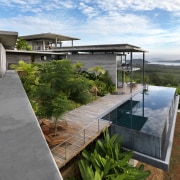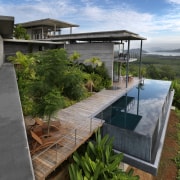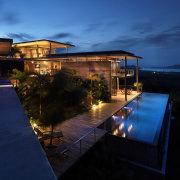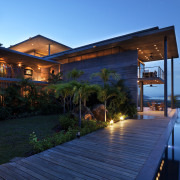Paradise found
Going off the grid doesn't have to mean sacrificing the comforts of home
Sustainable design, green building, natural construction these are all terms with which we are becoming more familiar in the residential sector. However, there are relatively few houses that truly measure up to these designations.
Environmentally friendly homes have tended to fall victim to a lack of understanding on the part of the general public, who envision small adobe-style structures with little aesthetic appeal. The reality is entirely different, says architect John Bulcock of Design Unit.
"My first approach is to design a passive house, one that works with the natural contours of the site, combined with architectural features that mitigate solar gain and promote natural ventilation and light."
Because of the remote setting and tropical climate, natural ventilation and sustainability were primary concerns for the owners of this house. At the start of construction there were no water, electricity or sewerage connections. Even now, only electricity is connected.
"We weren't particularly daunted by the prospect of not having any of these services," says owner Gary Dublanko, who, along with partner Dea Zoffman, took on the role of main contractor. "We had already spent 10 years living in the tropics, and had a good understanding of the limitations of conventional housing, in terms of energy usage."
The couple's desire for a fully self-sustaining home led them to Bulcock, who, after several site visits, presented them with the concept for their new house.
"The steeply sloping site falls 21m, so the intention was for the house to hug the slope as it steps down," says Bulcock. "This has resulted in a series of subterranean, semi-subterranean and cantilevered spaces. Not only did this reduce the impact on the site, in terms of cut and fill, but also created a stable internal temperature. It also opened the house to the environment."
The house is made up of two diverging, primary structures, linked by a minor structure at the top of the site. Further down the slope, the swimming pool and deck act as additional linking elements.
"The spaces have been kept open as much as possible even the bathrooms are open to the environment only the bedrooms are fully enclosed. Full-height mosquito nets in the living areas allow the spaces to remain open overnight without admitting pests," says Bulcock.
Constructed entirely from concrete, the house presents a stable thermal mass that, combined with natural ventilation and a design that mitigates solar gain, regulates the interior temperature. The owners have found that their reliance upon air conditioning is minimal.
"For 10 months of the year we don't use air conditioning at all," says Dublanko. "The house has abundant natural air flow, and cools down quickly at night. On still days, a fan is all we need. Visitors always tell us how comfortable the house is."
Further cooling strategies include minimal hard landscaping and roof planes that are either green roof or pebble, creating garden spaces for entertaining as well as providing additional insulation for interior spaces.
Rain water is collected from the roofs and channelled into an 80,000-litre underground tank. During the dry season, water from a 72m well supplements the tank. All waste water is treated on site by an Aerotol septic system.
"At the start of the process, we specified that the house had to be low maintenance and energy efficient," says Dublanko. "The result has exceeded our expectations and the experience has been most rewarding. Unfortunately, work commitments mean we have to move. But we're keen to build again and definitely plan to ask John to design our next home which we're hoping will be carbon-zero this time."
Story by: Trendsideas
Home kitchen bathroom commercial design
Diving into nature
Classic looks, contemporary efficiency
Personality plus
















